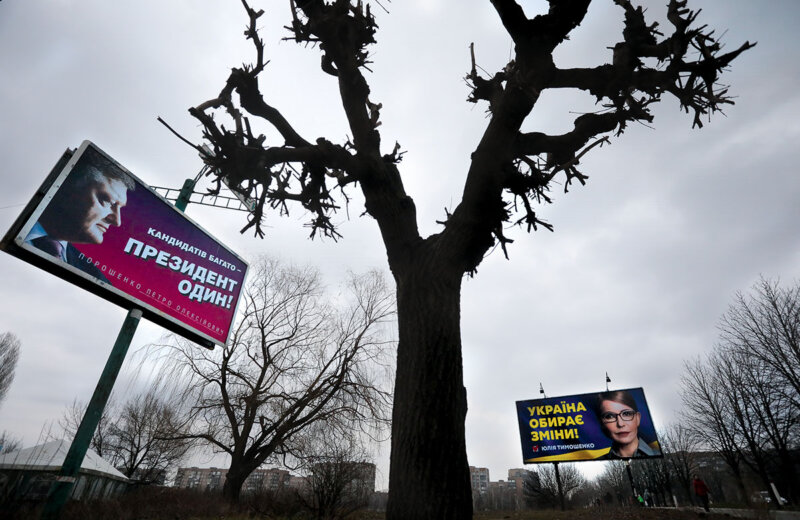Editor’s Note: Election Watch is a regular update on the state of the presidential race in Ukraine. The country will elect its next president on March 31, 2019, with a possible runoff on April 21. The Election Watch project is supported by the National Endowment for Democracy. The donor doesn’t influence the content.
It’s showtime. On March 31, Ukrainians will vote for the next president. President Petro Poroshenko will try to stay in his chair for five more years while 38 other candidates will try to stop him — but only two of them, Yulia Tymoshenko and Volodymyr Zelenskiy, have realistic chances. Polls show that none of the candidates win a majority of the votes — and so a runoff election between the top-two candidates awaits the nation on April 21.
Final polls
The last polls came out on March 28. In accordance with the Ukrainian law, election surveys can’t be published in the last two days before the vote.
Two days before the election, political satirist and actor Volodymyr Zelenskiy, who is running his first campaign for a public office, is leading in all polls. Zelenskiy’s lead has remained uncontested since late January.
While Zelenskiy’s support also hasn’t grown in the past several weeks, remaining within 22–28 percent in most polls, he still keeps a 10-point lead over his closest recipients.
Two polls, by Rating Group and Democratic Initiatives Foundation, showed 26.6 and 27.6 percent of the decided voters wanted to support Zelenskiy.
In the Rating Group’s poll, Poroshenko and Tymoshenko shared the second spot, both having 17 percent of support. The poll by the Democratic Initiatives showed Poroshenko (18.2 percent) ahead of Tymoshenko (12.8 percent).
At the same time, 15 percent of all voters remain undecided days before the election, according to Rating Group.
Runoff
Earlier polls predicted that among the three leaders, Zelenskiy had the highest chance of winning in the runoff. Tymoshenko would win against Poroshenko but lose to Zelenskiy, while Poroshenko would lose to either of them.
Numbers from one of the latest polls provide a fuller picture.
Rating Group asked voters who their second choice would be — or, in other words, who are they likely to support in the runoff, if their candidate doesn’t make it there.
The results were beneficial for Zelenskiy: He would get 19 percent of Tymoshenko’s voters, and from 14 to 18 percent of those who want to vote for Anatoliy Grytsenko, Yuriy Boyko, Oleksandr Vilkul, Oleh Lyashko, and Ihor Smeshko.
Tymoshenko, in her turn, is the second choice for 12 percent of Zelenskiy’s voters, and 17 percent of Lyashko’s. All three have led populist campaigns.
Poroshenko is less popular as the second choice: he is favored by the voters of the nationalist Ruslan Koshulynskiy, who polls at 2 percent, and the democratic candidate Grytsenko, who polls at 9 percent.
How many will vote?
The turnout will decide a lot in this election: Zelenskiy’s success depends on whether the less active young voters will show up to the election. According to the polls, up to half of 18–29-year-olds back him.
In the last polls by the Rating Group and the Democratic Initiatives, 87 percent and 85 percent of respondents said they were likely to vote in the election.
Back in 2014, polls predicted a turnout of 82 percent at the May presidential election. The real turnout was 60 percent.
Before that, the turnout for the first round of presidential elections has varied between 67 and 75 percent, with one exception of the first election in 1991, where 84 percent voted.
What changed since 2014 is that there is now 1.5 million of internally displaced people who fled the parts of eastern Ukraine that have been occupied by Russia-backed militants. To participate in the election, they needed to register to vote at their new addresses.
But according to the Central Election Commission, only 315,000 Ukrainians applied to change their voting address. Less than 100,000 of them were from the eastern Donetsk and Luhansk Oblasts.
One more factor might have some influence on the turnout: The Election Day is when Ukraine goes on summer time. Those who won’t pay attention and will try to vote in the last hour, will fail.
When will we know
The polling stations will be open from 8 a. m. to 8 p. m. on March 31. About then, pollsters will be set to announce the preliminary results of the national exit poll. At 11 p. m. on Election Day, the final results of the national exit poll will be in.
During the evening after the election, campaigns will release alternative exit polls. The 1+1 TV channel, a major station that has gone to great length to support Zelenskiy, will have its own exit poll.
The turnout will be announced within two hours of the 8 p. m. cutoff time.
The first results will start arriving in the early hours of April 1.
Opora election watchdog will announce the results of its parallel vote tabulation on April 1, while the Organization for Security and Cooperation in Europe’s Election Observation Mission will hold a press event the same morning.
In 2014, 20 percent of ballots were processed by 6 a. m. of the day after the election and 40 percent by 8 a. m. Although it took three days to complete the count, the majority of the ballots were processed by the end of the first day after the election. The runoff will take place on April 21, three weeks after the first round.



